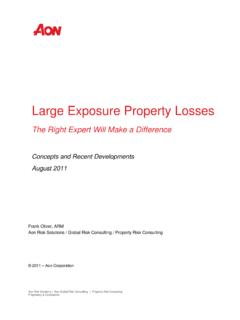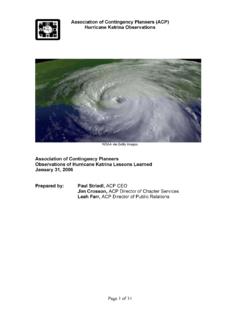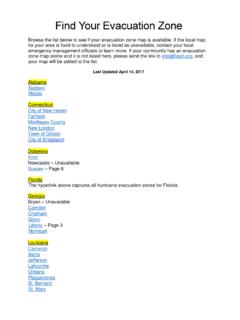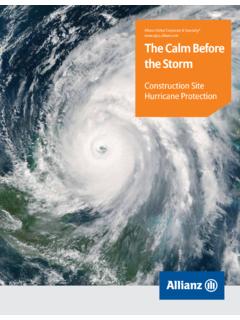Transcription of ProTek : Understanding Codes for Windborne Debris
1 ProTek : Understanding Codes for Windborne DebrisMike Gilbert, CDTB rand ManagerJuly 2010 YKK AP America Inc. is a registered provider with the American Institute of Architects Continuing Education Systems. Credit earned upon completion of this program will be reported to CES Records for AIA members. Certificates of Completion for non-AIA members are available upon request. This program is registered with the AIA/CES for continuing professional education. As such, it does not include content that may be deemed or construed to be an approval or endorsement by the AIA of any material of construction or any method or manner of handling, using, distributing, or dealing in any material or product. Questions related to specific materials, methods, and services will be addressed at the conclusion of this presentation. Thank you!Learning ObjectiveUsing the ASCE7 Standards and the detailed information provided in this seminar, the participant will be able to make more educated decisions when designing projects that must the stringent building requirements of hurricane prone Understanding Building Codes and Wind Borne Debris MitigationHurricanes Classifications History Power of a hurricane code Requirements Product Testing Recent Storms Bldg Codes React Glazing SystemsHurricane ClassificationsSaffir-Simpson ScaleCategory One: 74-95 MPHC ategory Two: 96-110 MPHC ategory Three: 111-130 MPHC ategory Four: 131-155 MPHC ategory Five.
2 Greater than 155 MPHU nited StatesLandfalling Hurricanes1950-2005 Safir-Simpson Categoryof Landfalling HurricanesCategory 1 Category 2 Category 3 Category 4 Category 5 Satellite Image hurricane AndrewAugust 24, 1992 Time Lapse Photo of AndrewStructural Requirements ASCE :The IBC & FL Building Codes reference ASCE 7 (American Society of Civil Engineers) to calculate a project s Design Pressure and define required protection from Prone Regionsare defined as: The Atlantic Ocean and Gulf of Mexico coasts where the basic wind speed is greater than 90mph. Hawaii, Puerto Rico, Guam, Virgin Islands, and American Borne Debris Regionsare defined as those areas within the hurricane Prone Regions located: Within 1-mile of the coastal mean high water line where the basic wind speed is equal to or greater than 110mphand Hawaii. In areas where the basic wind speed is equal to or greater than 7-98 Mid-AtlanticWind Borne Debris Regions for the NortheastASCE 7120110mph: 1-mile from the CoastWind Borne Debris Regions for the SoutheastASCE 7120 ASCE 7-98 Eastern Gulf Coast & TexasWind Borne Debris Regions for the Gulf Coast120 ASCE 7 High Velocity hurricane ZoneThe Florida Building code requires impact resistant systems for the HVHZ to be tested in accordance with: TAS 201 Impact (Large & Small) TAS 202 Air, Water, & Structural TAS 203 Cycle Test (Positive & Negative)TAS 201 requires each lite of glass to be impacted twice to pass the large missile test.
3 (ASTM E-1996 only requires one impact.)TAS 201 requires framing members to be impacted. (This is not a requirement of ASTM E-1996.)The Pass/Fail for TAS 201 is also more stringent than ASTM E-1996. TAS 201 limits a tear in the interlayer to 5 and no wider 1/16 . ASTM E-1996 states that a tear in the interlayer may not be longer than 5 and may not permit a 3 sphere to pass through. HVHZI mpact Test RequirementsLevel B2lb @ 50 f/sLevel @ 50 f/sLevel D9lb @ 50 f/sLevel E9lb @ 50 f/s9lb @ 50 f/s2g @ 130 f/s(10) 2 Gram Steel BallsLarge MissileSmall MissileMissileMissile2 X 4 LumberASTM E-1996 TAS 201(HVTZ)ASTM E-1996( Impact Location)( Impact Location)Pass/Fail No Tear Permitting a 3 Sphere to Pass Through No Tear Longer than 5 Pass/Fail No Tear Longer than 5 and 1/16 in WidthPass/Fail No Tear Permitting a 3 Sphere to Pass Through No Tear Longer than 5 Pass/Fail No Tear Longer than 5 and 1/16 in WidthTAS 201(HVTZ)2g @ 130 f/sCyclic Pressure Loading Inward-Acting Pressure (Positive)Range max max 3, max max max max max max 100 Total.
4 4,500P max is the design wind pressure from the building code based on an unbreachedbuilding Pressure LoadingOutward Acting Pressure (Negative) Range max max max max 1, max max max max 3,350 Total: 4,500P max is the design wind pressure from the building code based on an unbreachedbuilding envelope. Calculating Design Pressure in Accordance with ASCE 7 Method 1allows for a simplified procedure as specified in section for building meeting these 2allows for an analytical procedure as specified in section 3allows for Wind Tunnel procedures as specified in section Design Pressure Calculations(Old Method)It used to be a very simple calculation: Velocity2 X = Design PressureDesign Pressure Calculations(Current Method)Now, many other factors are used in the calculation to determine the required design pressure for allareas of the Wind Speed and Directionality Importance Factor Exposure CategoryTopographic FactorGust Effect FactorEnclosure ClassificationInternal Pressure CoefficientExternal Pressure CoefficientVelocity PressureDesign Wind LoadDesign Pressure ComparisonExample: 50 Tall Building 100 Minimum Width 120 mph Basic Wind SpeedOld Way.
5 1202X = psfNew Way:ASCE 7 Mid-Zone Positive = + psf Mid-Zone Negative = psf Corner Zone Negative = psfBuilding Importance Factor (ASCE 7)Category I: Buildings & Structures that Represent Low Hazard to Human Life Agriculture Buildings & Storage FacilitiesCategory II:All Buildings & Structures Except Those Listed in Categories I, III, or IVCategory III:Building & Structures Where More than 300 People Congregate (Schools are 250 or Greater)Category IV: Buildings & Structures Designated as Essential Facilities Buildings that Contain Toxic or Explosive Material Hospitals, Fire Rescue, Police Communication Centers, Power Stations hurricane SheltersBuilding Exposures Categories (ASCE 7)Exposure B:Urban & Suburban AreasExposure C: Open Terrain with Scattered Obstructions Less than 30 Feet Including Flat Open Country & Grasslands & Shorelines in hurricane Prone RegionsExposure D:Flat, Unobstructed Areas and Water Surfaces outside hurricane Prone Regions.
6 This Category includes Smooth Mud Flats, Salt Flats, and Unbroken Ice. B = The Least Width for the BuildingDetermine Minimum Building Width (Footprint) ASCE 7-98 Corner Zone Dimension a = X Minimum Bldg Width, But Not Less Than 3 -0 Determining Near Corner Zone Dimension a Required Design Pressure Chart Based on Bldg Height and Basic Wind SpeedBLDGIMPORTANCE WINDPOSITVEMID-ZONE ZONE 4 NEAR CORNER ZONE 5 HEIGHTFACTORSPEED ZONES 4 & 5 NEGATIVENEGATIVE50' psf100' psfASCE 7 System Requirements in Corner ZonesIntermediate Verticals May Require Reinforcing @ for Corner-Zone Frames20'-0" 5'-0"5'-0"5'-0"5'-0"3'-0"8'-0"5'-0"(15) Thus Mid-Zone(4) Thus Corner-ZoneCorner Zone+ Positive Pressure- Negative PressureDesigning for Wind PressureThis graphic illustrates the effects of wind forces on a building. The arrows indicate positive forces pushing on the surface and negative pressures pulling on the opposing side of the wind forces impact and vary on every surface of the building.
7 In most cases the pulling (-) forces are the higher loads. Photo:Plywood Driven Through a Palm TreePhoto:2 X 4 Piece of Wood Driven Through a Palm TreeNote: Height of ImpactIncreased Internal Pressure+ Positive Pressure- Negative PressureIncreased Internal Pressure Occurs When the Building Envelop is Breached by Flying graphic represents the effects of internal pressure when windows and doors fail. Wind enters and creates additional pressure that can lead to catastrophic damage to a of a HurricaneBuilding Envelop Breached Due to Loss of WindowsRoof Failure Due to Increased Internal PressureASCE 7 RequirementsProtection from flying Debris may be accomplished with either a shutter system (plywood or steel) or a glazing system designed and tested to resist the more than 45 tall may NOTuse wood shutters for protection from wind borne ShuttersMetal ShuttersImpact Resistant Glazing SystemWill Plywood Provide Protection for Homes?
8 ShuttersWill Plywood Provide Protection for Homes?Yes!ShuttersWill Protective Glazing Systems Provide Protection for Buildings?Protective Glazing SystemWill Protective Glazing Systems Provide Protection for Buildings?Protective Glazing SystemYes!DangerNew Protective Glazing SystemOld Glazing SystemSecurityFlying DebrisShutters Are Not Possible For Most Commercial Glazing & ProtectionStandard Annealed/TemperedNo Protection from Harmful Ultraviolet LightEasily Broken by Flying DebrisOffers No ProtectionApplying Mastic/Duct Tape to Standard GlazingFalse Sense of SecurityEasily Broken by Flying DebrisOffers No ProtectionConventional Glazing & ProtectionPlywood CoveringsMust be Stored or Purchased at Time of NeedMust Be Installed as the hurricane ApproachesNo Protection if Not Securely AnchoredStorm ShuttersMust be Taken Out of StorageMust Be Installed as the hurricane ApproachesNo Protection if not Securely AnchoredLeaves Holes at Anchor LocationsConventional ProtectionShutter ProtectionStorefronts left vulnerable to damage due to anchor failure!
9 Shutter ProtectionStorefronts left vulnerable to damage due to anchor failure!2004 Storm Track2004 Storm TrackCharlieFrancesIvanJeanne2005 Storm Track2005 Storm TrackKatrinaWilmaRitaWilmaDamage from Flying DebrisNew YKK AP LOGOD amage from Flying DebrisNew YKK AP LOGOD amage from Flying DebrisNew YKK AP LOGOD amage from Flying DebrisNew YKK AP LOGOR oofing Material Blown off by Storm!Impact Resistant Framing SystemsThe concept is to maintain the integrity of the building envelope by developing glazing systems that provide protection from wind borne Debris without the use of have been established to test the ability of a glazing system to resist impacts from both large and small missiles and the strong buffeting winds associated with Labs have been licensed to conduct the test and to certify the Missile Impact TestTest as a Total System :The building Codes require that the all of the components that make up a protective glazing system be tested together: Framing System Gaskets Structural Silicone Glass Anchors Total System testing ensures that the glazing system will provide the desired level of Glazing SystemsStorefronts and Entrances.
10 Large Missile - Silicone Glazed Small Missile - Dry Glazed Monolithic & Insulated Glazing Thermally Broken Option Doors as Large as 8 -0 X 8 -0 Hardware: MS Locks & Exit Devices Check with System Manufacturer Design Pressures up to 90psf Optional Water Resistant ThresholdsGlazing SystemsCurtain Walls: Large Missile - Silicone Glazed Small Missile - Dry Glazed Monolithic & Insulated Glazing Thermally Improved Glazed from Exterior or Interior 4-Side Capture or 2-Side Silicone Glazed Design Pressures up to -130psfGlazing SystemsOperable Windows: Large Missile - Silicone Glazed Small Missile - Dry Glaze Monolithic & Insulated Glazing Thermally Broken Options Configurations: Fixed Casement & Projected Vents Sliding Single & Double Hung Design Pressures up to -65psfGlazing SystemsSliding Glass Doors: Large Missile - Silicone Glazed Small Missile - Dry Glaze Monolithic & Insulated Glazing Thermally Broken Option Panels up to 4 -0 X 10 -0 Configurations: OX, OXO, OXXO Design Pressures up to -120psf Water Resistance up to 15 ~ 20psfBuilding StructureThe building itself must also be designed to meet the higher design pressures required to mitigate the damage from building structure that the window, storefront, or curtain wall are anchored to must be capable of caring the higher loads that will be transferred through the glazing system anchors.


















